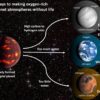In cosmic voids where the density of galaxies is far lower than standard, astronomers have observed weak magnetic fields that may provide a window into the early universe. The fields 10-17-10-10 G in magnitude with large coherence lengths of up to megaparsecs are thought to have their origins in the early universe, but so far it is unclear when or how they were generated. One hypothesis is that an imbalance in the numbers of “left-handed” and “right-handed” fermions may be at the heart of it, as this could give rise to helical magnetic fields. But so far there has been no detailed analysis as to how the evolution of the numbers of left- and right-handed fermions might stack up against this hypothesis. Now a collaboration of researchers in Europe report a more rigorous analysis of this chirality imbalance with surprising results.
The handedness or chirality of fermions is a fundamental property of quantum particles (relevant for the description of the weak interaction between them). “For massless fermions it coincides with the particle’s helicity, i.e. the projection of the particle’s spin on the direction of its movement,” explains Oleksandr Sobol, a postdoctoral researcher at the Ecole Polytechnique Fédérale de Lausanne in Swtizerland and the University of Kyiv, and corresponding author on this latest report. “However, for real massive fermions there is no simple analogy.”
Oleksandr explains that certain processes can flip the chirality, which tends to even out the imbalance in fermion chirality over time. So far cosmologists have relied on an estimate of this decay rate based on the simplest reactions involved in these processes. According to these principles the decay rate is proportional to the square of a fundamental constant known as the fine structure constant, which quantifies the strength of electromagnetic interactions between fundamental particles. However, one of the things this estimate fails to take into account is the way particles in a plasma differ from particles in a vacuum. It turns out that this has a significant impact on calculations of the probability of one of the scattering processes that can flip a particle’s chirality.
Environmental effects
In any scattering process, the momentum is transferred from one colliding particle to another, explains Sobol. The lower the momentum transferred, the higher the probability that scattering will occur. In their analysis of the chirality imbalance decay rate, he and his collaborators focus largely on Compton scattering where an electron and photon collide, which can flip the electron’s chirality. Here as Sobol highlights, when the electron and photon interchange their momenta without the momenta values changing much, the scattering probability can really skyrocket, growing so fast that integrating over all possible momentum transfer values tends to infinity—a so-called infrared singularity, where infrared refers to the low momentum transfer involved.
“Obviously, this is not physical, because all quantities should remain finite,” adds Sobol, pointing out that taking into account the differences between particles in plasma and in vacuum can resolve the issue. “The environment changes the energy dispersion of particles and makes their lifetime finite.” By taking these environmental effects into account the researchers were able to make all the quantities finite. What they also found to their surprise, was that one of the fine structure constants in the chirality decay rate relation then cancels out so that the rate becomes linearly proportional to the fine structure constant.
The change in the relation describing the decay rate gives it a value two orders of magnitude faster than that set by the previous estimate. While such a large discrepancy may sound like something that should have been picked up somewhere along the line before—or at least checked—it is only recently that numerical calculations using these values have really been viable. “The quantitative analysis of plasmas with chiral imbalance requires complicated and numerically costly simulations which people were not able to perform many years ago,” says Sobol. “In other words, until recent times the exact numerical value of the chirality flipping rate was not needed.” He also highlights that it was also unclear how to calculate this rate, as it requires some “non-trivial” maths—a double perturbative expansion, in the fine structure constant and electron mass.
So, with such a fast decay rate confirmed is that game over for theories of primordial magnetic fields generated through fermion chirality imbalance? Not quite. As Sobol points out another key factor is how fast the chirality imbalance can be transferred into the magnetic field. “This rate is still unknown and it definitely should be calculated,” says Sobol. “Only knowing both rates one could conclude about the possibility of the magnetogenesis in this model.”
Electromagnetic chirality: From fundamentals to nontraditional chiroptical phenomena
More information:
A. Boyarsky, et al. Evolution of the primordial axial charge across cosmic times, Physical Review Letters, Accepted Manuscript. journals.aps.org/prl/accepted/ … 0b533d788635232a0481
Arxiv: arxiv.org/abs/2007.13691
2020 Science X Network
Citation:
Are primordial magnetic field theories getting in a twist? (2020, December 14)
retrieved 14 December 2020
from https://phys.org/news/2020-12-primordial-magnetic-field-theories.html
This document is subject to copyright. Apart from any fair dealing for the purpose of private study or research, no
part may be reproduced without the written permission. The content is provided for information purposes only.



